 |
Ravensdale reflected in the still water at Maryport Marina in Cumbria, UK |
The second anniversary of moving on board Ravensdale seemed a good time to reconsider the lessons we’ve learned since selling our house to buy our 43ft seagoing cruiser.
I undertook this exercise after our first anniversary so thought it was worth revisiting one year on to see whether there was anything new I could add.
It seems the lessons learned remain much the same, but some have been proved to be even more true after year two than we thought after our first year.
The main thing we discovered during year one remains unchanged – you need much less stuff than you think when living on a boat.
And I’m ashamed to admit that we still have way too much stuff.
As before, the other big one is the cost of maintaining a boat of this size although we haven’t had to spend anywhere near as much on her this year as we did in our first year as liveaboards.
I know there are plenty of people out there who have been doing this for much longer than us, who will have far more knowledge than we’ve managed to glean so far.
However, I hope our experiences may help others in a similar situation to us and those trying to decide whether they would enjoy life aboard.
Lessons we’ve learnt over the first two years
1. You need to get rid of a lot more stuff than you think
 |
Phil tearing his hair out while trying to sort storage on Ravensdale |
We got rid of almost everything we owned between agreeing the sale of our house and the day we moved out – or so I thought.
But it seems we didn’t get rid of anywhere near enough stuff.
When we first moved on board, we rented a 75sqft shore-based storage unit, which we downsized to 50sqft and 25sqft over the first six months or so.
The aim was to get rid of it altogether within a year.
We didn’t manage to achieve that and we’re still paying for it a year later.
We rarely go there – usually only to get the Christmas decorations before the festive season and to return them afterwards or when we can’t find something we want on the boat and think it could be hiding in storage.
One day, I’m determined to go over there and be totally ruthless with the contents as most of it hasn’t been touched since the day we put it there, so I can’t help thinking that means we no longer need it.
We also have a smaller area of storage at the marina, but this is mainly stuff we use more often.
 |
Phil putting stuff in the marina storage container |
And, we’re only allowed to buy anything new for the boat if it’s useful or attractive (preferably both) and, most importantly, we know we’re going to keep it.
2. Maintaining a boat costs more than you expect
 |
Ravensdale during her lift-out for antifouling, replacing the anodes and stern gland repacking |
There were things we needed or wanted to do to Ravensdale when we first bought her that we knew would cost us money – such as having a holding tank fitted.
There were also a number of other things that needed sorting that we had no idea were going to be needed.
And we were well aware that there would always be ongoing maintenance costs.
But we really didn’t realise just how often she would expect us to shell out for various things that break or just pack up working, but then she is 34 years old, so I guess we should have realised that.
We now know that it really is true that BOAT stands for Break Out Another Thousand 😊
3. Identify local engineers, electricians, etc. before you need them
 |
Phil helping Norman removed the heat exchanger from Ravensdale's starboard engine for cleaning |
Life has been much easier over the past year than it was when we first moved on board because, when something goes wrong that we can’t fix ourselves, we now know who to go to for help.
If we ever decide to relocate to another marina, we’ll make sure we find folk able to do these things before we need them.
4. You need to be able to do as much maintenance as possible yourself
 |
Phil removing the heat exchanger from Ravensdale's port engine for cleaning |
This is probably a no-brainer really and it’s something we always intended to do but living on Ravensdale has made us realise just how important it is.
You need a full set of tools, a multimeter to measure electric current and a comprehensive collection of spares.
We’re learning more about the boat all the time.
When a job presents itself that Phil can’t do himself, we get someone to do it and, if possible, get them to show us how it’s done so we can deal with it ourselves the next time.
Doing our own maintenance not only keeps the costs down a bit, but more importantly, means that if something goes wrong when we’re out on the water, we will hopefully be able to fix it ourselves.
5. Dehumidifiers are worth their weight in gold
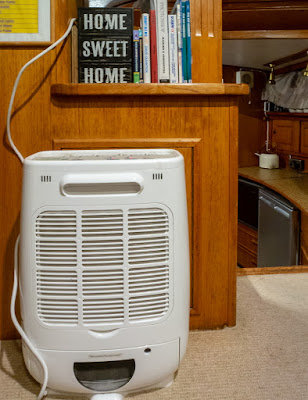 |
One of our two dehumidifiers |
This became apparent very early on but the longer we’ve been living on Ravensdale the more convinced I’ve become that we couldn’t live on a boat without them.
We have two powerful dehumidifiers – each of them is supposed to be able to cope with a five-bedroom house.
We keep one in the aft cabin, which is where we sleep, and one in the forward cabin.
Both are used daily except during periods of warm, dry weather when opening the windows is all that’s needed to air the boat.
The dehumidifier in the aft cabin runs on high for about an hour before we go to bed at night and an hour after we get up in the morning and this seems to be sufficient to keep the cabin dry.
And the one in the forward cabin is run on a low setting all night with the door to the cabin left open so it can also draw any moisture from the galley, dinette and saloon.
This one is moved up into the saloon during the day if the windows start to get condensation on them – usually while cooking or washing up and sometimes when it rains.
Using our dehumidifiers in this way means we never get a damp problem on board.
6. Use the marina showers as much as possible
(This point is linked to the one above)
We have an en suite shower on Ravensdale, which is in its own little room off the aft cabin.
It’s an excellent shower and there’s plenty of room to use it in comfort, but we tend to only use it when the weather’s warm and dry as using it in cold or damp weather makes it more difficult to keep the boat dry.
We would obviously use it if either of us was unable to go up to the marina shower block for any reason but, when we can, we use the marina showers.
Our marina has excellent facilities and we can use as much hot water as we want, whereas showering on the boat means we need to restrict the amount of hot water we use.
That said, the marina facilities can get busy in the summer when the marina’s caravan site is open so that’s another good reason to use our own shower even if it does mean running the dehumidifier afterwards.
7. It’s worth getting a slow cooker
(Also linked to the two points above)
 |
Our slow cooker |
We were given a slow cooker a few months ago and wish we’d got one sooner.
Not only does it mean we can cook our food on low power, it also seems to eliminate the condensation caused by cooking on the top of the stove.
8. You will lose more stuff in the water than you can imagine
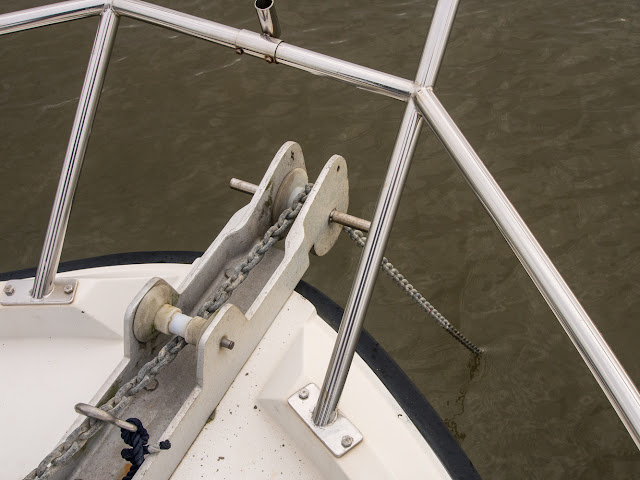 |
The nylon roller that was lost to the water while changing the pin holding it in place |
If you drop anything on a boat, it will end up in the water and the chances of retrieving it are virtually nil or at least that’s what seems to happen to us.
I still haven’t worked out how anything dropped on deck will always manage to find its way off the boat and into the water.
So far, we’ve lost Phil’s favourite filleting knife, various nuts and bolts, catches and a nylon roller that holds the end of the anchor and chain in place when it’s on board.
Those are just the things I can think of off the top of my head. I’m sure there are many more 😊
I guess the lesson learnt on this one is, if you can tie it on or put a float on it, then do so – my keys have a float on them and are always clipped to a belt loop.
Thankfully, neither of us have managed to lose a mobile phone into the water yet but we know plenty of people who have.
Often this has been due to them falling out of top pockets while the owner was bending over so we try to make sure that ours are always in zipped pockets or, at least, in pockets from which they are unlikely to fall out.
9. A diesel fund is a top priority
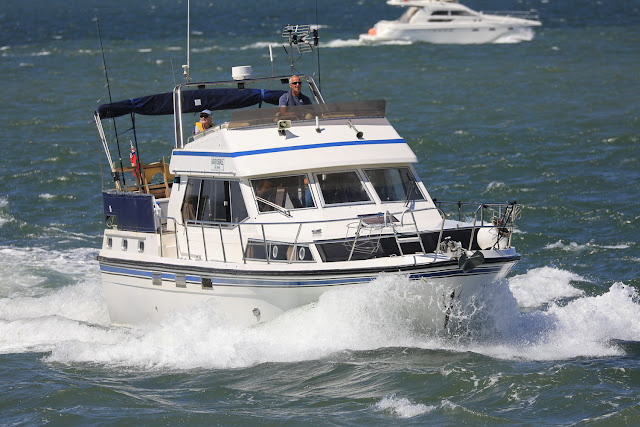 |
Ravensdale out on the Solway Firth. Photo by Ronnie Bell |
We set up a separate bank account for a diesel fund before we moved on board and set up a standing order to pay a regular amount into it every month.
We’ve continued doing this and it has proved invaluable as it ensures we always have funds available to pay for fuel for both heating and propulsion.
Keeping the money in a separate account also means that it never feels as bad having to pay out hundreds of pounds to fill our 1200 litre fuel tank when the money has already been set aside for the purpose.
10. Consider dropping a stone or two if you’re overweight
 |
Before and after - me last September (left) and me earlier this month (right) |
I added this one as a bit of a joke after my list of lessons learned at the end of our first year but, having lost the best part of a stone and half in the past four or five months, I no longer consider it to be a joke.
It’s made a huge difference to my enjoyment of life on board.
Even on our 43ft Neptunus 133 there’s less space to move around than in most houses and being bigger makes life more difficult than it needs to be.
This is true both in terms of space and ease of movement as there seems to be a lot bending down involved, such as using low drawers under seating.
I could do with losing a bit more so will continue to stick to the diet until I get to my ideal boat weight 😊
Other first-year lessons learned
 |
Our bed with the new, comfortable mattress we ordered to replace the existing thin, hard one |
Other things I included in last year’s “lessons learned” list were the importance of fitting the biggest holding tank you have room for and buying the most comfortable mattress you can afford.
Both things are still equally true another year down the line.
We’d also discovered that we didn’t miss having a washing machine as our marina has a good launderette. However, I guess I may think differently if we weren’t in a marina or if there was no launderette nearby.
And I can’t even believe I mentioned not missing a dishwasher. Hand washing dishes really isn’t the most difficult task ever 😊
This week
The first half of this week was very wet and windy, which meant a lot of time spent inside Ravensdale.
But at least it gave me time to put together a photo book of the past year as a Christmas present for my elderly parents, who’ve never seen Ravensdale or the area in which we live and are never going to be able to get here now.
 |
The cover of the photo book I've made for my Mum and Dad for Christmas |
I made one of our first year afloat for them for last Christmas and they loved it so much that I decided to make it an annual thing.
Thankfully, the weather has been a lot better over the last couple of days.
However, the marina gate hasn’t been open at a suitable time for going out fishing on a single tide and the gate timings haven’t been great for going out over two tides.
Broken light
One of the long cushions from the seating in the saloon touched one of the two ceiling lights while we had it off to get to the storage under the seats and the glass bowl split in two and fell to the ground, smashing as it hit the floor.
As this was caused by a slight touch by a soft seat cushion, we can only think that the glass bowl was already cracked so I suppose it was lucky it didn't fall out when someone was sitting or standing underneath it.
 |
The light fitting in Ravensdale's saloon that got broken this week |
We’ve been trying to find an identical lamp to replace it, but without success.
Similar lamps are available, but we haven’t found one as big as the one that was broken.
As there are two lights in the saloon and they need to match, we’ve decided to move the identical light from the dinette up into the saloon.
We can then get a new light to go over our dining table as it doesn’t really matter if it doesn’t match those in the saloon.
Swan family
We didn’t see the swan family for much of last week, but they turned up looking for food on Saturday morning and have returned every afternoon or evening this week.
 |
The swans and cygnets on one of their visits for food this week |
They always seemed to arrive when it was wet and windy, so I ended up having to put on a waterproof jacket to go out and feed them.
Photography
The bad weather didn’t really encourage me to spend too much time out taking photos.
However, I took full advantage of the times when the weather was better and took my camera out for a few walks along the shore and around the marina.
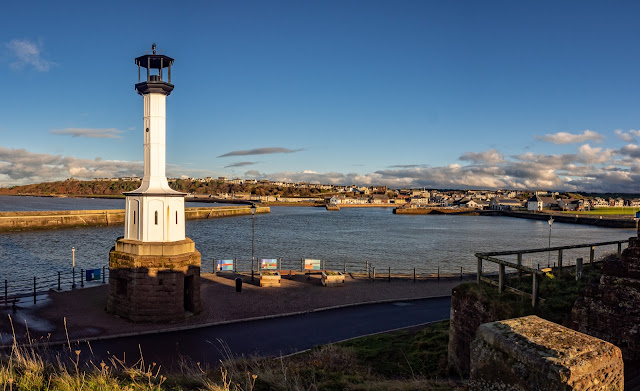 |
Maryport Lighthouse with the town in the background |
 |
Looking out along Maryport Pier at dusk |
 |
Maryport Marina sea gate from the basin |
 |
Maryport Marina gate closing |
 |
Waves whipped up by high winds by Maryport Pier |
 |
Another image of the big waves crashing onto the shore at Maryport |
 |
A wider view of the waves on the shore at Maryport |
 |
An interesting cloud formation over Maryport Marina |
And I headed over to the beach for the sunset last night (Thursday).
 |
Sunset on Maryport beach |
 |
Another view of last night's (Thursday) sunset |
 |
The golden light reflected on the sea |
Weather watch
Overnight Friday into Saturday was a very windy night with a top average wind speed of 47mph, gusting 68mph.
Saturday morning started dry and cloudy with sunny intervals. It was also much calmer than overnight. It started raining mid-afternoon and kept it up for the rest of the day.
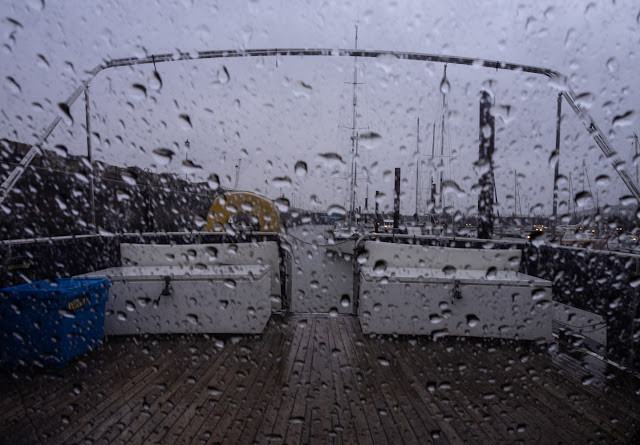 |
Soggy Saturday on Ravensdale at Maryport Marina |
The highest temperature recorded locally was 10.2C (50F) and the top average wind speed during the day was 23mph, gusting 31mph.
We had a miserable wet start to the day on Sunday and it carried on raining all morning.
The sun came out during the afternoon, but the wind and rain returned in the evening. The temperature only reached 9.5C (49F) and the wind speed peaked at 19mph, gusting 31mph.
 |
A dry spell on Sunday afternoon |
It was raining when we got up on Monday morning after another windy night with wind speeds of up to 25mph, gusting 37mph. The weather brightened up a bit late morning before the rain returned around lunchtime and continued for most of the rest of the day. The top temperature was 9.8C (50F) and the top average wind speed was 25mph, gusting 37mph.
Monday night into Tuesday morning was another windy night.
Tuesday was a better day with less rain but there was still plenty of wind around. The temperature reached 10.5C (51F).
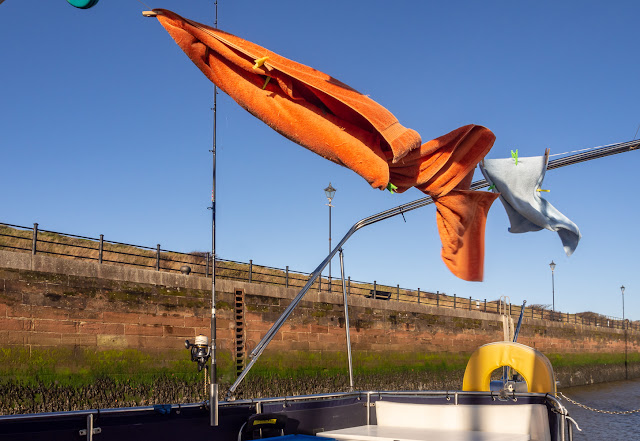 |
Towels blowing around in the wind on Ravensdale's aft deck on Tuesday |
The wind dropped off a little during the day building up again during the evening giving a top average wind speed of 23mph with gusts of up to 32 mph.
Tuesday/Wednesday night was wettest and windiest of the past week with a top overnight wind speed of 32mph, gusting 43mph. It was followed by an equally wet and windy morning with the weather clearing later in the afternoon.
 |
Wet Wednesday at Maryport Marina |
Yesterday (Thursday) turned out to be much better than was forecast.
It was cloudy with sunny intervals and much calmer than expected.
The highest temperature recorded at St Bees Head, which is the nearest location at which weather data is collected, was 11.5C (53F) and the top average wind speed was given as 25mph, gusting 37mph, but it was definitely much lower than that here.
And, so far, today (Friday) it has been dry, calm and overcast. The top temperature was 12.3C (54F) and the top wind speed was given as 19mph but again it seemed much lower here in Maryport.
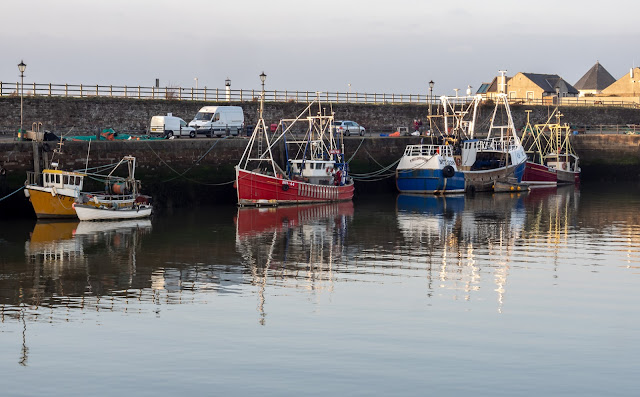 |
Calm, sunny conditions at Maryport Harbour this afternoon (Friday) |

Hi Sue and Phil. Many thanks for posting your Annual blog, it is very interesting. This is something i aspire to do- live on a boat, with a slight difference; a yacht. I have yet to convince my wife that it is a good idea, i'm using the "carrot" approach in as much as if she lets us live on a boat then she can retire early! I'm hoping it's a big enough "carrot" :-)
ReplyDeleteGood useful comments about the de humidifier and mattress, I fully understand both, however, the dehumidifier i assume is 240volts so is only useable when plugged in to the mains or is it 12v, indeed are there 12v ones available?
That's a huge tank of diesel you have there, how long is a tank lasting you and what is the price of red diesel?
Maryport is a lovely part of Cumbria, in fact i was looking at a yacht there earlier in the year but sadly we couldn't agree a price. What is the furthest distance you have motored on an excursion?
And your bedroom looks lovely and cosy, i think this is the answer to a happy life of comfort on board. I look forward to reading further blogs.
kind regards
Andy and Jane. x
Hi Andy and Jane, Glad you enjoyed reading my blog and I hope Jane decides to take the carrot - the very same carrot worked for me :-) Yes, our dehumidifiers are 240V. So far, we've only run them when we're in a marina but could use them while at anchor with our generator running, if we needed to do so. The last time we filled up with diesel at the marina it cost £0.77 for heating and £1.26 for propulsion with the customer deciding on the relevant percentages. The furthest we've gone so far is Kirkcudbright in Dumfries and Galloway, Scotland, but we're planning to go a bit further afield next year. And, in case you're interested, I write a weekly blog. All the old posts can be accessed via the links in the blog archive on the right hand side of my current blog post. All the best, Sue
Delete